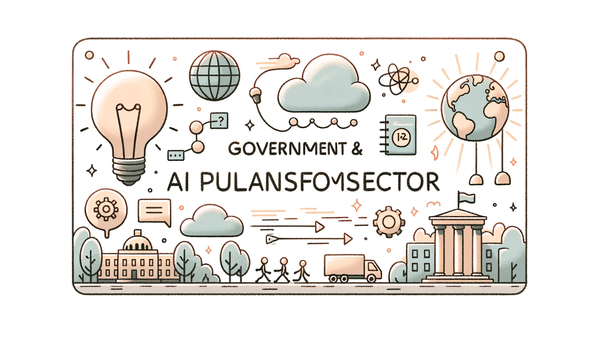Emerging Trends in AI: Innovations, Investments, and Implications
This article provides an in‐depth look at several pivotal developments in artificial intelligence—from a major sales surge by Nvidia’s AI server maker Hon Hai to CoreWeave’s strategic acquisition of the AI development platform Weights & Biases, the revolutionary advances in SOC automation powered by Hunters’ Pathfinder AI, the impressive funding milestone reached by Zeitview for AI‐powered infrastructure inspections, and the evolving challenges of data sovereignty in the cloud era. By exploring these diverse topics through detailed analysis, expert commentary, and real-world examples, we uncover the dynamic shifts in the AI ecosystem and their broader implications on business, technology, and security.
AI Market Momentum: Nvidia and Hon Hai’s Sales Surge
The AI landscape often moves as fast as a high-speed train, and recent financial results have only confirmed this pace. Nvidia’s AI server maker, Hon Hai, has reported a 25% jump in sales over just two months, underscoring the growing demand in high-performance AI infrastructures. While details beyond the headline may be sparse, this robust growth is a strong indicator of the increasing appetite for sophisticated AI hardware solutions. For those following the innovations in hardware acceleration, this development adds further credence to the claim that AI has matured from a future prospect into the present-day engine driving technological and industrial transformation.
In the context of AI market dynamics, such a sales surge is emblematic of the industry’s volatile yet prosperous climate. Hardware manufacturers like Hon Hai are not only reaping the benefits of advanced AI server architectures, but also contributing to a broader ecosystem that supports software, cloud processing, and the large-scale computational needs of modern AI workloads. This momentum brings exciting opportunities for businesses seeking to integrate AI into their core operations, ensuring rapid deployment and scalability.
Drawing on historical parallels, one might compare this shift to the industrial revolution's impact on manufacturing; then, as now, breakthroughs in technology serve as a catalyst for broader economic change. In fact, on a recent discussion, an industry insider mentioned that “the ability to quickly scale AI solutions is the golden ticket to unlocking new markets and operational efficiencies.”
CoreWeave’s $1.7 Billion Investment in AI Innovation
In another striking move within the AI ecosystem, CoreWeave—the data center company backed by Nvidia—is making headlines. The company recently acquired the AI development platform Weights & Biases for an estimated $1.7 billion. Founded in 2017 by Lukas Biewald, Chris Van Pelt, and Shawn Lewis, Weights & Biases has grown rapidly, earning a valuation of $1.25 billion in 2023 before filing for an IPO. The platform is trusted by over 1,400 organizations, including major players such as AstraZeneca and Nvidia, to support the nuanced tasks of training and fine-tuning AI models.
This acquisition isn’t just a financial transaction; it is a strategic alignment that positions CoreWeave to offer an integrated cloud service environment tailored for AI development. Businesses now have access to streamlined workflows that simplify application development and accelerate market-ready innovations. CoreWeave’s decision sends a clear signal to the industry: invest in platforms that simplify the iterative process of AI model training and deployment.
“Complex problems require innovative solutions and the combination of robust cloud capabilities with specialized AI development tools is a breakthrough moment,” commented an AI strategist during a recent industry panel.
For developers and innovators alike, the acquisition represents an opportunity to interface directly with a suite of tools that optimize model performance while reducing overhead. For those interested in delving deeper into the acquisition and its implications, additional details are available on TechCrunch.
As organizations globally look to capitalize on AI, the move by CoreWeave reinforces the need for agile, dynamic frameworks that can embrace both the increasing complexity and scale of modern artificial intelligence applications. This trend of consolidating services to provide unified AI solutions is likely to charge ahead as a dominant force within the tech industry.
Smarter Security Operations with Hunters’ Pathfinder AI
In parallel with these infrastructure developments, another sector undergoing significant transformation is cybersecurity. Hunters, a prominent name in security operations, has introduced Pathfinder AI—a system that marks a revolutionary shift in Security Operations Center (SOC) automation. By integrating Agentic AI capabilities, Pathfinder AI enables autonomous security investigations, data analysis, and swift response to emerging threats.
Traditionally, SOCs have been challenged with the arduous task of sifting through voluminous alerts, wherein analysts would often be led astray by false positives and time-consuming manual investigations. With the introduction of Pathfinder AI, these challenges are not only mitigated, but the entire investigative process is transformed. The AI-powered system is designed to filter distractions, prioritize genuine threats, and even perform automated root cause analyses, thereby ensuring that human operators are supported rather than supplanted.
The evolution from tools like Copilot AI—which provided targeted investigative guidance—to Agentic AI’s full autonomy represents a significant technological leap. The new capabilities include natural language querying, lead summarization, and guided investigation workflows that elevate operational effectiveness. This is especially pertinent in the current cybersecurity climate where speed is of the essence and the cost of error can be monumental.
For organizations seeking enhanced threat management, implementing systems like Pathfinder AI can redefine defensive postures. The shift underscores a broader movement in cybersecurity towards leveraging AI not just for detection, but for reactive and even proactive security measures. Further reading and detailed technical specifications can be explored through the GlobeNewswire release.
Observing this gradual transition, it becomes apparent that the future of security operations may well rest in the hands of intelligent systems that work alongside human analysts – a point emphasized by unconventional thinkers who remind us that “Real stupidity beats artificial intelligence every time,” a sentiment famously voiced by Terry Pratchett.
Funding New Frontiers: Zeitview’s $60M for AI-Powered Inspections
While the details on Zeitview’s recent funding remain more concise in their public disclosure, securing $60 million to further AI-powered inspections of global critical infrastructure is an impressive milestone that highlights the importance of AI in industries beyond the digital realm. The capital infusion is expected to bolster advanced AI technologies that monitor, analyze, and predict the health of vital infrastructure components worldwide.
Critical infrastructure—from energy grids and water supplies to transportation networks—forms the backbone of modern society. As these systems become entwined with digital operations, ensuring their reliability and resilience through AI-driven inspection techniques becomes paramount. Advanced image recognition algorithms and sensor data analysis, powered by machine learning models, are already proving instrumental in detecting faults, predicting failures, and optimizing maintenance cycles.
For instance, AI methods are increasingly deployed in high-risk environments to monitor equipment performance in real-time, thus pre-empting catastrophic failures and reducing maintenance costs. The significant investment in Zeitview reflects both a confidence in, and a necessity for, such transformative technologies in enhancing global infrastructure security and operational efficiency.
As companies adapt to the shifting dynamics of their industries, this infusion of funds will likely accelerate the integration of AI in sectors that have historically relied on traditional monitoring methods. In doing so, it paves the way for smarter, more responsive management of our global infrastructure.
Data Sovereignty: Navigating the Complexity of the Cloud Era
Beyond the hardware and operational improvements in AI and cybersecurity, a pressing challenge in today’s technology landscape remains data sovereignty. The shift toward extensive cloud computing has unlocked unprecedented operational efficiencies, but it has also introduced complex legal and security challenges. Data sovereignty is all about a nation’s—or even an organization’s—ability to control data residing within its borders, a topic that becomes increasingly significant as data breaches and privacy issues dominate headlines worldwide.
Recent insights from a well-regarded source explain that navigating data sovereignty is no walk in the park. International regulations like the US CLOUD Act and the EU's GDPR require companies to implement stringent data classification, encryption, and compliance-related measures to ensure sensitive information remains secure. The Thales Data Threat Report emphasizes that many enterprises rank these concerns at the top of their agendas.
Companies find themselves wrestling with the dual needs of keeping data accessible for practical usage while safeguarding it against unauthorized access. Encryption plays a central role in this balancing act. Robust key management strategies—ranging from generating independent encryption keys to deploying advanced, multi-layered cryptographic methods—ensure data protection across its lifecycle.
Moreover, as emerging technologies such as quantum computing take shape, there is an added urgency to evolve existing encryption methodologies. The shift toward post-quantum cryptography is no longer optional but essential—an evolution that promises to secure data against even the most advanced cyber threats of tomorrow.
There is also a future where next-generation connectivity options, including 5G and 6G networks, necessitate a new approach to data sovereignty. Such networks will significantly boost data throughput and efficiency, but they also herald a new era of potential vulnerabilities. The increased complexity of data flow may inadvertently expose sensitive information to privacy breaches unless robust protocols and legal frameworks are established.
In this context, a well-known insight by Gray Scott comes to mind: "The real question is, when will we draft an artificial intelligence bill of rights? What will that consist of? And who will get to decide that?" This quote encapsulates the broader concern of establishing a balanced and equitable framework for data governance in an AI-enabled future.
Bridging the Gaps: Convergence of AI Technologies and Business Strategies
When viewed collectively, these developments are not isolated incidents. They represent the convergence of multiple streams of innovation that are rapidly reshaping how industries operate in a digital-first world. The juxtaposition of a 25% surge in AI server sales, a high-stakes acquisition valued at billions, a new era in SOC automation, fresh funding for critical infrastructure inspections, and the intricate challenges of data sovereignty illustrates the interconnectedness of today’s technological advancements.
Businesses striving to remain competitive must therefore adopt a multi-pronged approach. They need to invest in the physical infrastructures that power AI workloads even as they strengthen their cybersecurity postures and navigate the ever-evolving legal landscape around data privacy. Our discussions in boardrooms increasingly highlight the strategic interdependence between robust IT infrastructure, cutting-edge software platforms, and proactive regulatory compliance.
For example, the moves by CoreWeave and Hon Hai are not just about boosting performance—they are strategic bids to consolidate various layers of the tech stack into an integrated whole that can reliably support next-generation AI innovations. In the same vein, the deployment of Pathfinder AI in security operations is a testament to the sector’s readiness to embrace automation in areas where time and accuracy are critical.
As I reflect on these strategic trends, I am reminded that the story of AI today is as much about business strategy as it is about technical prowess. The integration of advanced AI systems into everyday business operations marks a turning point—one where agility, foresight, and a holistic view of technology integration become the hallmarks of success.
This convergence is also evident in the realm of global critical infrastructure management. With AI’s influence penetrating deeply into industries like energy, transportation, and public safety, organizations can no longer view their operations as isolated islands. Instead, they must adopt strategies that connect infrastructure intelligence, cybersecurity, and regulatory compliance in a seamless loop. Such an integrated approach is critical to ensure that operational efficiencies translate not only into financial gains but also into a secure and resilient future.
Looking to the Horizon: Emerging Trends and Their Implications
As we peer into the horizon of future technological illustrations, several emerging trends merit mention. First, the rapid evolution of AI-driven automation indicates that industries—from manufacturing to healthcare—will soon witness widespread transformation in the way routine tasks are performed. Whether it’s predictive maintenance in factories or diagnostic imaging in clinics, AI-enabled automation will redefine operational efficiency and productivity.
Second, the ongoing consolidation within the AI ecosystem—illustrated by high-profile acquisitions and strategic partnerships—signals a shift towards integrated, one-stop platforms that provide end-to-end solutions, from AI model development to seamless cloud deployment. This certification of convergence ensures that companies looking to integrate AI into their strategies will benefit from scalable and resilient solutions offered by established tech players.
Simultaneously, the challenges posed by data sovereignty and privacy will only intensify as AI systems become more pervasive. It is essential for both policy framers and industry leaders to work in tandem to create frameworks that protect sensitive data while also encouraging innovation. The interplay between regulation and technology is delicate, as seen by the simultaneous growth in digital capabilities and the intensifying debates over information privacy.
Furthermore, as connectivity initiatives like 5G and 6G rapidly roll out, they not only enhance the performance of cloud-based services but also compound the complexity of data management on a global scale. Several experts caution that a deeper understanding and a proactive approach may be required to mitigate potential privacy challenges before they escalate into larger security risks.
Reflecting on these trends, I am reminded of a timeless observation: technological revolutions are rarely isolated events. Instead, they intersect with economic strategies, geopolitical dynamics, and cultural shifts. In this light, the stories from Nvidia, CoreWeave, Hunters, and Zeitview provide valuable case studies on how disparate elements of the tech industry can combine to forge a future that is both resilient and dynamic.
Further Readings and Perspectives
For those who wish to expand their understanding of these developments, consider exploring the following resources:
- Nvidia AI Server Maker Hon Hai Reports Major Sales Surge – get more insight into the hardware trends driving AI.
- CoreWeave Acquires AI Developer Platform Weights & Biases – understand the strategic significance of this acquisition.
- Hunters’ Pathfinder AI for Smarter SOC Automation – learn about advancements in cybersecurity automation.
- Under the Hood of Data Sovereignty – delve into the complexities of data residency and compliance in today’s digital age.
Each of these perspectives not only highlights the remarkable progress being made in AI but also underscores the need for strategic foresight and balanced regulation as these technologies become ubiquitous in our daily lives.
Conclusion: Embracing the Future with Informed Innovation
As industries transition into the next phase of digital transformation, the synthesis of cutting-edge AI technology, robust security measures, and enlightened data governance emerges as the blueprint for success. The advancements covered—from Hon Hai’s impressive sales jump to CoreWeave’s billion-dollar acquisition, from Hunters’ game-changing SOC automation to Zeitview’s bolstered AI-powered inspections—represent key chapters in the unfolding story of a more connected, secure, and innovative future.
It is through embracing such transformations, while simultaneously addressing the legal and ethical concerns associated with data sovereignty, that businesses can harness the full potential of AI. This period of rapid change requires not only technical prowess but also a strategic vision that bridges the gap between innovation and responsible practices.
Many industry thought leaders agree when they assert that the journey ahead will demand careful navigation of competing priorities—balancing speed with security, innovation with regulation, and global ambition with localized ethical standards. In this delicate balance lies the path to creating a truly transformative, yet resilient, digital world.
In the end, being proactive, informed, and agile is not just a competitive advantage; it is a necessity in a world where technology evolves at breakneck speed. For innovators and businesses alike, the race is on not only to adopt new technologies but also to shape the policies and practices that will govern them for years to come.




